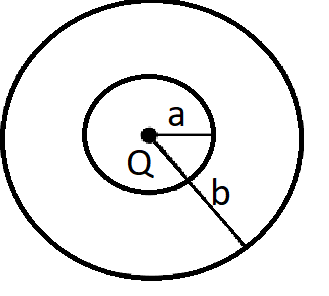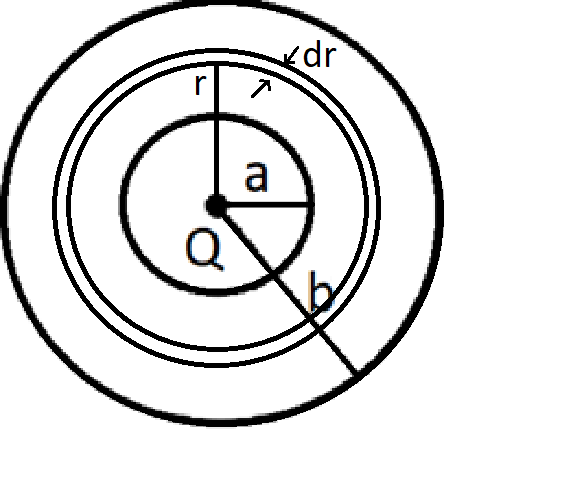
The region between two concentric spheres of radii ‘a’ and ‘b’, respectively, has a volume charge density of $\rho =\dfrac{A}{r}$, where A is constant and r is the distance from the centre. At the centre of the sphere is a point charge Q. The value of A such that the electric field in the region between the spheres will be constant, is:

A. $\dfrac{Q}{2\pi {{a}^{2}}}$
B. $\dfrac{Q}{2\pi ({{b}^{2}}-{{a}^{2}})}$
C. $\dfrac{Q}{2\pi ({{a}^{2}}-{{b}^{2}})}$
D. $\dfrac{Q}{\pi {{a}^{2}}}$

Answer
513.5k+ views
Hint: This question is an application of the concept of Flux that was given by Gauss. We can easily find the formula using Gauss's Theorem. Take a small element dr and then integrate. While integrating, set a and b as lower limit and upper limit respectively.
Complete answer:
Let us consider a sphere between two concentric spheres lying in the area of radius r and thickness dr. Charging within alone leads to electric field / flux according to Gauss' theorem.

So,
We have
\[\Rightarrow \dfrac{kQ}{{{a}^{2}}}=\dfrac{k[Q+\int\limits_{a}^{b}{4\pi r2drAr}]}{{{b}^{2}}}\]
Where, k is coulomb’s constant, and a, r, and b are the radii of the three concentric circles respectively.
Now,
On integrating, ‘rdr’
In accordance with the power rule of integration, i.e.,
$\int{{{x}^{a}}dx=\dfrac{{{x}^{a+1}}}{a+1}}$
So,
We have
\[\Rightarrow Q\dfrac{{{b}^{2}}}{{{a}^{2}}}=Q+4\pi A[\dfrac{{{r}^{2}}}{2}]_{a}^{b}\]
\[=Q+4\pi A\dfrac{({{b}^{2}}-{{a}^{2}})}{2}\]
\[\Rightarrow \dfrac{Q\left( {{b}^{2}}-{{a}^{2}} \right)}{{{a}^{2}}}=2\pi A\left( {{b}^{2}}-{{a}^{2}} \right)\]
So, now
We have
\[A=\dfrac{Q}{2\pi {{a}^{2}}}\]
So, the value of A such that the electric field in the region between the spheres will be constant, is \[\dfrac{Q}{2\pi {{a}^{2}}}\]
So, the correct answer is “Option A”.
Note:
The law of Gauss, also known as the flux theorem of Gauss, is a law of physics relating to the propagation of electric charges to the resulting electric field. A closed one enclosing a volume such as a spherical surface might be the surface under consideration.
Complete answer:
Let us consider a sphere between two concentric spheres lying in the area of radius r and thickness dr. Charging within alone leads to electric field / flux according to Gauss' theorem.

So,
We have
\[\Rightarrow \dfrac{kQ}{{{a}^{2}}}=\dfrac{k[Q+\int\limits_{a}^{b}{4\pi r2drAr}]}{{{b}^{2}}}\]
Where, k is coulomb’s constant, and a, r, and b are the radii of the three concentric circles respectively.
Now,
On integrating, ‘rdr’
In accordance with the power rule of integration, i.e.,
$\int{{{x}^{a}}dx=\dfrac{{{x}^{a+1}}}{a+1}}$
So,
We have
\[\Rightarrow Q\dfrac{{{b}^{2}}}{{{a}^{2}}}=Q+4\pi A[\dfrac{{{r}^{2}}}{2}]_{a}^{b}\]
\[=Q+4\pi A\dfrac{({{b}^{2}}-{{a}^{2}})}{2}\]
\[\Rightarrow \dfrac{Q\left( {{b}^{2}}-{{a}^{2}} \right)}{{{a}^{2}}}=2\pi A\left( {{b}^{2}}-{{a}^{2}} \right)\]
So, now
We have
\[A=\dfrac{Q}{2\pi {{a}^{2}}}\]
So, the value of A such that the electric field in the region between the spheres will be constant, is \[\dfrac{Q}{2\pi {{a}^{2}}}\]
So, the correct answer is “Option A”.
Note:
The law of Gauss, also known as the flux theorem of Gauss, is a law of physics relating to the propagation of electric charges to the resulting electric field. A closed one enclosing a volume such as a spherical surface might be the surface under consideration.
Recently Updated Pages
Master Class 12 English: Engaging Questions & Answers for Success

Master Class 12 Business Studies: Engaging Questions & Answers for Success

Master Class 12 Economics: Engaging Questions & Answers for Success

Master Class 12 Social Science: Engaging Questions & Answers for Success

Master Class 12 Maths: Engaging Questions & Answers for Success

Master Class 12 Chemistry: Engaging Questions & Answers for Success

Trending doubts
What are the major means of transport Explain each class 12 social science CBSE

Which are the Top 10 Largest Countries of the World?

Draw a labelled sketch of the human eye class 12 physics CBSE

Explain sex determination in humans with line diag class 12 biology CBSE

The pH of the pancreatic juice is A 64 B 86 C 120 D class 12 biology CBSE

Explain sex determination in humans with the help of class 12 biology CBSE




